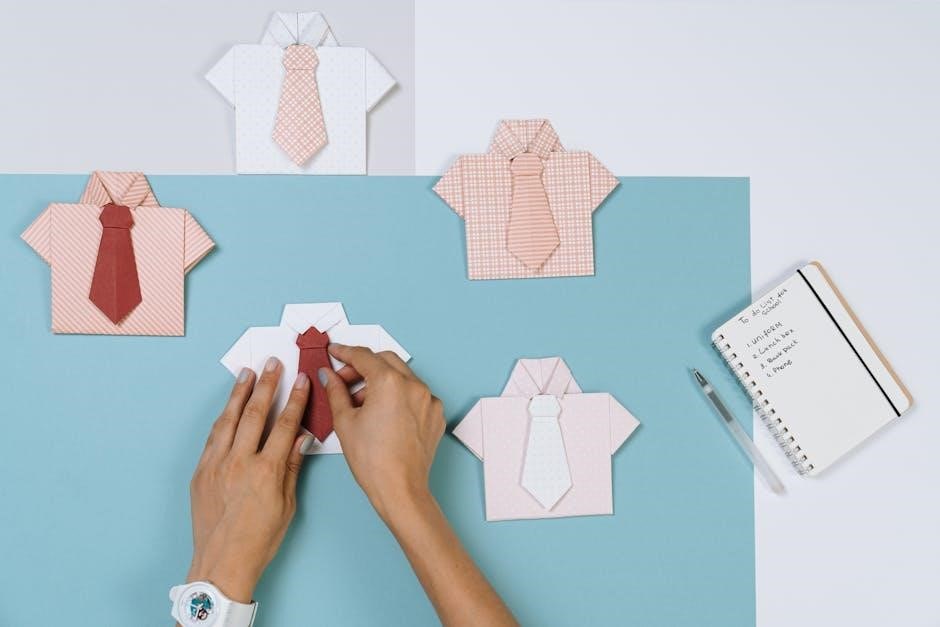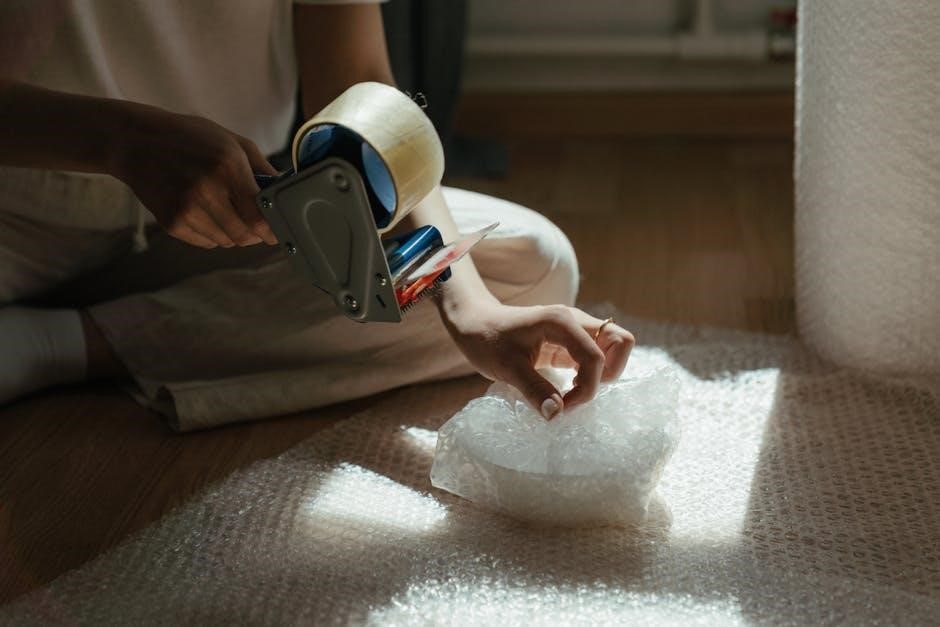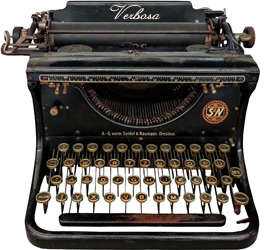K’NEX instructions provide step-by-step guides for building various creations, ensuring accuracy and fun. These manuals are essential for both beginners and experienced builders, offering clear directions and diagrams. Visit the official K’NEX website for authentic PDF downloads tailored to specific sets and projects.
1.1 What Are K’NEX Instructions?
K’NEX instructions are detailed guides that help users assemble and build specific K’NEX models. These manuals, often available as PDFs, provide step-by-step directions, diagrams, and part lists to ensure accurate construction. They are essential for both beginners and experienced builders, offering clear visual and written instructions. K’NEX instructions are designed to make building fun and educational, allowing users to create complex structures like roller coasters or simple designs with ease. By following these guides, users can unlock the full potential of their K’NEX sets and enjoy a seamless building experience.
1.2 Importance of Following K’NEX Instructions
Following K’NEX instructions is crucial for successful project completion. These guides ensure that each piece is used correctly, preventing structural issues and safety hazards. By adhering to the instructions, users can avoid missing parts or incorrect assembly, which might lead to unstable or non-functional creations. Additionally, following the steps helps in understanding the mechanics and design principles behind each model, enhancing the learning experience. Properly built structures are safer, more durable, and visually appealing, making the effort to follow instructions worthwhile for an enjoyable and rewarding building experience with K’NEX sets.
1.3 Benefits of Using K’NEX Instructional Guides
K’NEX instructional guides offer numerous benefits, including clear step-by-step directions and visual diagrams to aid in assembly. They help users understand complex designs and ensure all pieces are used correctly. These guides enhance the learning experience by teaching problem-solving and engineering concepts. For educators, they provide structured lesson plans, aligning with STEM goals. Additionally, instructional guides reduce errors and save time, allowing builders to focus on creativity. PDF versions are easily accessible and printable, making them a convenient resource for both beginners and experienced builders. Overall, they maximize the enjoyment and educational value of K’NEX sets.

Finding K’NEX Instructions Online
Looking for K’NEX instructions? The official K’NEX website offers authentic guides, while third-party sites provide additional PDF resources. Easily download and access your preferred manuals online.
2.1 Official K’NEX Website Resources
The official K’NEX website is the most reliable source for authentic instruction manuals. It offers a wide range of PDF guides tailored to specific sets and models. Users can easily search and download manuals by product name, set number, or category. The website is user-friendly, ensuring quick access to the resources you need. Additionally, it provides support for lost or missing instructions, making it a one-stop solution for all K’NEX enthusiasts. Regular updates and a comprehensive library ensure you always have the latest guides at your fingertips.
- Authentic and verified manuals.
- Easy search and download options.
- Support for missing instructions.
- Updated resource library.
2.2 Third-Party Websites Offering K’NEX PDFs
Several third-party websites offer K’NEX instructions in PDF format, providing alternative access to manuals for various sets. These platforms often cater to users who have lost their original instructions or prefer digital versions. Websites like Scribd, Google Drive, and specialized forums host a wide range of K’NEX guides. However, users should exercise caution to ensure the authenticity and accuracy of these documents. Some third-party sites may offer outdated or incorrect manuals, which could lead to building errors. Always verify the source and cross-check the content with official resources when possible.
- Popular platforms include Scribd and Google Drive.
- Useful for lost or missing manuals.
- Verify authenticity to avoid errors.
2.3 How to Download K’NEX Instructions as PDFs
To download K’NEX instructions as PDFs, visit the official K’NEX website or trusted third-party platforms. Search for your specific set by model number or name. Once found, click the download link to save the PDF. Some sites may require account creation or verification. Ensure the file is from a reliable source to avoid errors. Organize your downloads in a dedicated folder for easy access. Printing the PDF allows for physical reference during building. Always check for updates to ensure you have the latest version of the instructions.
- Search by model number for accuracy.
- Verify the source to avoid incorrect guides.
- Organize files for easy access.

Types of K’NEX Sets and Their Instructions
K’NEX offers diverse sets like Thrills, Imagine, Education, and Classic, each with unique instructions tailored to their specific building style and complexity level.
- Thrills: Roller coasters and amusement park models.
- Imagine: Creative, open-ended building sets.
- Education: STEM-focused kits for learning.
- Classic: Traditional construction sets.
3.1 K’NEX Thrills Roller Coasters Instructions
K’NEX Thrills Roller Coasters Instructions provide detailed step-by-step guides for building intricate amusement park models. These PDFs include diagrams for tracks, loops, and supports, ensuring stability and realism. They often feature motorized components for dynamic movement. Instructions emphasize proper piece alignment and tension for smooth operation. Tips for customization and troubleshooting are also included, making these guides essential for both beginners and experienced builders. Downloading these manuals ensures you can create thrilling roller coasters with precision and creativity, bringing your amusement park visions to life.
3.2 K’NEX Imagine Building Sets Instructions
K’NEX Imagine Building Sets Instructions offer guides for creating imaginative structures, fostering creativity and open-ended play. These PDFs provide step-by-step directions for various themes, from houses to spaceships, using versatile rods and connectors. Instructions often include tips for customization, allowing builders to adapt designs to their vision. With clear diagrams and organized parts lists, these manuals make it easy to bring unique ideas to life. They cater to all skill levels, encouraging experimentation and learning through hands-on construction, making them perfect for sparking creativity in builders of all ages.
3.3 K’NEX Education Kits Instructions
K’NEX Education Kits Instructions are designed to align with STEM learning objectives, providing structured lessons for students. These PDF guides include step-by-step instructions for building models that teach engineering, physics, and math concepts. Suitable for classrooms or homeschooling, they cater to various age groups and skill levels; The instructions often feature experiments and activities to reinforce learning; Detailed yet easy to follow, they help students develop critical thinking and problem-solving skills. These kits are ideal for educators seeking hands-on tools to make complex concepts engaging and accessible for learners.
3.4 K’NEX Classic Construction Sets Instructions
K’NEX Classic Construction Sets Instructions provide detailed guides for building timeless models like roller coasters, bridges, and towers. These PDFs are ideal for both kids and adults, offering a variety of projects to suit different skill levels. The instructions are visually oriented, with clear diagrams and step-by-step directions. They emphasize creativity and precision, allowing users to master fundamental building techniques. Tips for organizing pieces and troubleshooting are often included. Perfect for beginners or those revisiting classic designs, these manuals ensure a fun and rewarding building experience while fostering creativity and problem-solving skills.

Understanding K’NEX Instruction Manuals
K’NEX instruction manuals provide clear, detailed guidance for assembling sets, ensuring users understand each step. They combine visuals and text, catering to all skill levels for easy comprehension.
4.1 Components of a K’NEX Instruction Manual
A K’NEX instruction manual typically includes a parts list, showcasing all components needed for assembly. It features step-by-step instructions, often with visuals, to guide builders. Detailed diagrams illustrate each stage, while color-coded rods and connectors simplify identification. Some manuals include troubleshooting tips to address common issues. They may also offer assembly variations or customization ideas. Clear organization and visual aids ensure users can follow along confidently, making the process enjoyable and stress-free for both beginners and experienced builders.
4.2 Reading K’NEX Instructional Diagrams
K’NEX instructional diagrams are designed to be clear and visually intuitive. They often feature detailed illustrations of each step, showing how pieces connect. Color-coding helps differentiate between rod lengths and connector types. Symbols and labels highlight specific actions, like where to attach rods or how to align parts. Understanding these visuals is key to assembling your K’NEX creation accurately; By carefully following the diagrams, builders can ensure proper alignment and orientation of components. This visual guidance makes it easier to bring your K’NEX project to life, even for those new to building with these sets. Mastery of the diagrams enhances the overall experience.
4.3 K’NEX Color-Coded Instructions Explained
K’NEX instructions often use color-coding to simplify the building process. Different colors correspond to specific types of rods and connectors, making it easier to identify the correct pieces. For example, red rods might indicate longer pieces, while green connectors could signify unique angles. This system helps builders quickly locate the right components without confusion. Color-coding is particularly useful in complex models, ensuring accuracy and saving time. By referencing the color key provided in the instructions, users can efficiently navigate through the assembly process and achieve the desired results with precision and confidence.

Tips for Building with K’NEX Instructions
Organize pieces before starting, follow step-by-step guides, and use a flat surface for stability. Double-check each step and keep the PDF handy for quick reference.
5.1 Organizing K’NEX Pieces Before Building
Organizing K’NEX pieces is crucial for a smooth building experience. Begin by sorting rods, connectors, and other components by type and color. Use small containers or trays to keep similar parts separate. This helps in quickly locating specific pieces during assembly. Refer to the K’NEX instructions PDF to identify all required parts beforehand. Clear your workspace and lay out pieces in an accessible manner. For larger sets, consider grouping pieces by the order they appear in the instructions. A well-organized setup ensures less clutter and reduces the risk of missing parts.
5.2 Following Step-by-Step K’NEX Guides
Following step-by-step K’NEX guides ensures your project turns out as intended. Start by carefully reviewing the K’NEX instructions PDF to understand the sequence of steps. Begin with the foundation or base pieces, as they provide stability. Pay attention to the orientation of rods and connectors, as shown in the diagrams. Work methodically, completing one section before moving to the next. Avoid skipping steps, even if they seem simple. If a step is unclear, refer back to the instructions or zoom in on the diagrams for clarity. Patience and attention to detail are key to a successful build.
5.3 Troubleshooting Common K’NEX Building Issues
Common issues during K’NEX building include pieces not fitting as expected or structures collapsing. If a piece doesn’t align, double-check the K’NEX instructions PDF for correct orientation. Ensure all connections are secure and rods are fully inserted. For instability, review earlier steps to confirm proper assembly. Missing pieces can be identified by cross-referencing the parts list in the guide. If unclear, consult online forums or K’NEX community resources for troubleshooting tips. Patience and careful re-examination often resolve most issues, helping you get back on track to completing your project successfully.

Advanced K’NEX Building Techniques
Explore custom designs by modifying K’NEX sets, adding unique twists to standard instructions for personalized creations that showcase creativity and skill beyond basic builds;
6.1 Custom K’NEX Creations Beyond Instructions
Unleash creativity by designing custom K’NEX projects that go beyond standard instructions. Start by experimenting with unique piece combinations and configurations to create original structures. Use existing PDF guides as inspiration but diverge to add personal touches. For complex designs, sketch or plan digitally before building. Online forums and communities often share tips and ideas for custom builds. Remember, practice improves skill, so don’t hesitate to retry and refine. Custom creations not only enhance problem-solving abilities but also showcase individuality and innovation in K’NEX building;
6.2 Modifying K’NEX Sets for Unique Designs
Take your K’NEX building to the next level by modifying existing sets to create one-of-a-kind designs. Start by identifying pieces that can be repurposed or reconfigured to achieve a new look or function. Combine elements from multiple sets or incorporate custom connectors for added flexibility. Sketch your ideas beforehand to visualize the final product. When altering structures, ensure stability by testing modifications in stages. Join online forums or communities for inspiration and tips on unique K’NEX modifications. This approach fosters creativity and allows you to personalize your builds beyond the original instructions.
6.3 Combining Multiple K’NEX Sets for Larger Projects
Combining multiple K’NEX sets opens the door to creating expansive and intricate designs. Start by inventorying pieces from each set to identify complementary components. Plan your large-scale project, whether it’s a sprawling cityscape or a complex machine, using K’NEX instructions PDFs as a foundation. Ensure structural integrity by reinforcing joints and bases. Organize pieces by type to streamline assembly. Prototype smaller sections first to test stability and functionality. Allow time for meticulous construction, and consider documenting your process for future reference or sharing with the K’NEX community. This method fosters creativity and showcases the versatility of K’NEX building systems.

K’NEX Instruction PDFs for Specific Models
K’NEX instruction PDFs provide detailed guides for building specific models, such as Ferris wheels, carousels, and towers. These PDFs offer step-by-step visuals and part lists for accuracy.
7.1 K’NEX Ferris Wheel Instructions PDF
The K’NEX Ferris Wheel Instructions PDF is a detailed guide for constructing iconic Ferris wheel models. It includes step-by-step instructions, part lists, and diagrams to ensure accuracy. The PDF is designed to help builders of all skill levels, from beginners to experienced enthusiasts. With clear visuals and organized sections, it simplifies the assembly process. Tips for troubleshooting common issues and optimizing the design are also provided. This resource is essential for anyone aiming to create a precise and functional Ferris wheel using K’NEX pieces. It ensures a smooth and enjoyable building experience.
7.2 K’NEX Carousel Instructions PDF
The K’NEX Carousel Instructions PDF provides a comprehensive guide for building intricate and colorful carousels. It includes detailed step-by-step instructions, diagrams, and a complete part list. Designed for both beginners and experienced builders, the PDF ensures a smooth assembly process. The guide emphasizes the importance of proper piece organization and alignment. Tips for achieving smooth rotational mechanics are also included. With clear visuals and easy-to-follow directions, this PDF helps users create a sturdy and visually appealing carousel. It’s an excellent resource for anyone looking to bring this classic amusement park attraction to life using K’NEX pieces.
7.3 K’NEX Eiffel Tower Instructions PDF
The K’NEX Eiffel Tower Instructions PDF offers a detailed guide to constructing a scaled model of the iconic landmark. Designed for intermediate to advanced builders, the PDF includes precise step-by-step instructions and diagrams. It covers essential techniques like rod-and-connector placement and structural stability. Tips for achieving the tower’s signature curved shape and symmetry are highlighted. The guide ensures builders can replicate the Eiffel Tower’s intricate ironwork design using K’NEX pieces. With clear visuals and organized instructions, this PDF is ideal for those aiming to create a durable and visually impressive replica of this architectural wonder.

Printing and Binding K’NEX Instructions
Printing K’NEX instructions ensures durability and easy reference. Binding manuals with sturdy materials enhances organization and protects them from wear, making your guides last longer.
8.1 Best Paper for Printing K’NEX PDFs
For printing K’NEX PDFs, choose durable, high-quality paper to ensure longevity and clarity. Opt for 100-120 gsm weight for strength and a matte finish for readability. If environmental impact is a concern, consider recycled options. Higher brightness enhances color vibrancy, beneficial for color-coded instructions. Balance cost and quality to avoid flimsy paper. Check reviews for recommended brands, prioritizing durability and finish for optimal results.
8.2 Binding K’NEX Manuals for Easy Reference
Binding K’NEX manuals enhances organization and accessibility. Spiral binding is ideal as it allows the manual to lie flat, perfect for following instructions. It is durable and can handle numerous pages. Perfect binding is another option, using adhesive for a paperback-like finish, though less durable than spiral. Ring binding offers flexibility but can be bulky. Comb binding is similar to spiral but uses plastic combs and is adjustable. Choose spiral or comb binding for durability and ease of use, ensuring your K’NEX guides remain accessible and secure for future projects.
8.3 Printing K’NEX Instructions in Color vs. Black and White
Printing K’NEX instructions in color enhances visibility of color-coded parts and detailed diagrams, making it easier to follow complex steps. However, it increases ink usage and cost. Black and white printing is more economical and faster but may reduce clarity, especially for color-coded instructions. Choose color for intricate sets like roller coasters or Ferris wheels, where color differentiation is crucial. Opt for black and white for simpler projects or when ink conservation is a priority. Both options ensure readability, but color provides better guidance for intricate designs.

Sharing and Community Involvement
Sharing K’NEX creations online fosters creativity and connects enthusiasts. Join forums, post projects, and collaborate to inspire others and gain new ideas for your builds.
9.1 Sharing K’NEX Creations Online
Sharing K’NEX creations online allows enthusiasts to showcase their innovative builds and connect with like-minded individuals. Platforms like Instagram, YouTube, and dedicated forums provide spaces to post images, videos, and PDF instructions. By using hashtags and joining communities, creators can gain visibility and receive feedback. Sharing not only inspires others but also fosters collaboration and learning. Whether it’s a custom roller coaster or an intricate sculpture, sharing K’NEX projects online helps build a supportive and creative community. So, upload your masterpiece and let others be amazed by your K’NEX skills!
9.2 K’NEX Fan Communities and Forums
K’NEX fan communities and forums are vibrant spaces where enthusiasts gather to discuss their passion for building. These platforms, such as Reddit’s r/KNEX or dedicated Facebook groups, offer a place to share ideas, ask questions, and learn from experienced builders. Fans often exchange tips on modifying sets, troubleshooting, and creating custom designs. These communities also host challenges and showcase impressive builds, fostering creativity and collaboration. By joining these forums, you can connect with fellow K’NEX lovers, gain inspiration, and even access shared resources like PDF instructions for rare or custom sets.
9.3 Collaborative K’NEX Building Projects
Collaborative K’NEX building projects bring enthusiasts together to create large-scale, intricate designs. These group efforts foster teamwork, creativity, and problem-solving. Participants can pool their skills, share ideas, and learn from one another. Collaborative projects often result in unique, innovative structures that might not be possible alone. They also provide opportunities to exchange tips, resources, and even PDF guides for custom builds. Many communities organize events or online challenges, encouraging members to contribute to a shared goal. These collaborations not only enhance building skills but also strengthen the sense of belonging within the K’NEX fan community.

Safety and Storage Tips
Ensure small K’NEX pieces are kept out of reach of young children to avoid choking hazards. Store rods and connectors in labeled containers to maintain organization and accessibility. Regularly clean pieces to prevent dirt buildup and ensure smooth connections. Always follow safety guidelines provided in K’NEX instruction PDFs. Proper storage prolongs the lifespan of your sets and instructions.
10.1 Safe Building Practices with K’NEX
Always handle K’NEX rods and connectors with care to avoid scratches or injuries. Ensure all connections are secure to prevent accidental collapses. Avoid using excessive force, as it may damage the pieces or cause sharp edges. Keep small parts away from children under three to prevent choking hazards. Build on a flat, stable surface to minimize risks of falling structures. Follow age recommendations for specific sets and supervise children during construction. Regularly inspect pieces for wear and tear. By adhering to these practices, you can enjoy a safe and enjoyable building experience with K’NEX.
10.2 Storing K’NEX Pieces and Instructions
Properly storing K’NEX pieces and instructions ensures longevity and organization. Use sturdy plastic bins or cases with dividers to separate rods, connectors, and other components. Label each container for easy identification. Keep instruction manuals in a binder or folder, organized by set. For digital PDFs, store them in a dedicated folder on your computer or cloud storage. Maintain a dry, cool environment to prevent damage. Regularly clean pieces to avoid dust buildup. This systematic approach ensures everything remains accessible and in good condition for future projects.
10.3 Keeping K’NEX Instructions Clean and Protected
To maintain the quality of K’NEX instructions, whether physical or digital, proper care is essential. For printed manuals, use acid-free paper and store them in protective sleeves or binders. Avoid exposure to moisture or direct sunlight. For PDFs, ensure they are saved in a secure, virus-free digital environment. Regularly back up files to an external drive or cloud storage. Handle both physical and digital copies with clean hands to prevent smudges. By taking these steps, you preserve the clarity and accessibility of your K’NEX instructions for future use.
K’NEX instructions provide a gateway to endless creativity and learning. By following these guides, builders of all ages can unlock their full potential and create amazing structures.
11.1 Final Thoughts on Using K’NEX Instructions
Using K’NEX instructions PDFs is a fantastic way to guide your creativity and ensure your projects turn out as envisioned. These manuals are designed to be clear and detailed, making it easier for builders of all skill levels to succeed. Whether you’re constructing a simple model or a complex roller coaster, following the instructions helps you avoid frustrations and enjoy the building process. The structured steps also foster problem-solving and critical thinking, making K’NEX a valuable educational tool. With patience and practice, you’ll master the art of building and unlock endless creative possibilities with K’NEX.
11.2 Encouragement to Explore More K’NEX Projects
Exploring more K’NEX projects is a rewarding way to expand your creativity and skills. With each completed model, you’ll gain confidence and discover new techniques to apply to future builds. Don’t hesitate to experiment and push your limits—whether it’s a intricate roller coaster or a simple creation, every project is an opportunity to learn and grow. The sense of accomplishment you feel when bringing a design to life is unparalleled. Embrace the process, and remember, K’NEX is not just a toy but a tool for fostering innovation and imagination. Keep building, and let your creativity soar!
11.3 Resources for Further K’NEX Learning
For those eager to dive deeper into K’NEX building, numerous resources are available to enhance your skills. The official K’NEX website offers a wealth of instructional guides, video tutorials, and tips. Additionally, third-party forums and communities provide user-generated content, including custom designs and troubleshooting advice. YouTube channels dedicated to K’NEX often feature step-by-step builds and creative ideas. PDF manuals for specific sets can be downloaded from trusted sources, ensuring you have all the guidance you need. Explore these resources to expand your knowledge and unlock new possibilities for your K’NEX creations.

